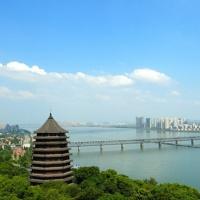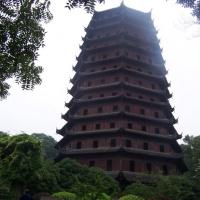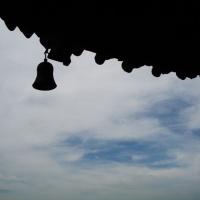The Six Harmonies Pagoda aka Liuhe Ta or Liu He Pagoda, one of the famous tours attractions in Hangzhou city, is located at the foot of Yuelun Shan (or Yuelun Hill, situated in the south of the West Lake) overlooking the famous Qiantang River. The name "six harmonies" stems from the six Buddhist ordinances, meaning "harmonies of the heaven, earth, north, south, east, and west".
With a purpose of keeping down the river tide, the Six Harmonies Pagoda was originally built in 970 AD (Northern Song Dynasty), rebuilt in 1153. The extant pagoda is an octagonal half-timbered pavilion-style structure, has thirteen levels on the exterior but seven levels on the interior, stands 59.89 meters high (about 196 feet), and is one of the tallest pagodas in southern China. It offers the panoramic view over the river and is a popular site for sunset viewing.



The walls of the pagoda were carved with human figures, flowers, birds, fish, insects, Chinese lucky animals and other decorative patterns, all vividly done. Visitors here may be shocked and entertained not only by the long and splendid history of China but also the arts of Chinese calligraphy and seal-cutting. There are various sorts of stone tablets and stone statues both inside and out of the pagoda, left over from the past times.
Behind the Six Harmonies Pagoda is the Chinese Ancient Pagoda Exhibition Park, in which there are a hundred miniatures of famous pagodas in the ancient times. In the park, tourists can see ancient Chinese pagodas with various architectural styles.
Photos
More>>history
Traditions
arts
- Architectural Design Institute receives important architectural awards
- HU Jintao receives HE Jingtang and other constructers of China pavilion of World
- President LI Yuanyuan and Academician HE Jingtang attend the Groundbreaking
- Press conference held for interpretation of SCUT's elements in 2010 Shanghai
- Over a thousand of students for professional degrees enroll in SCUT





